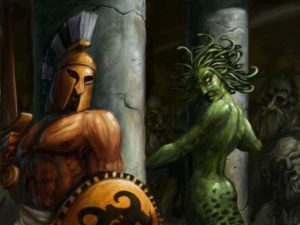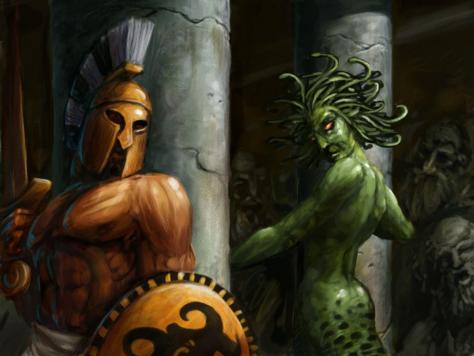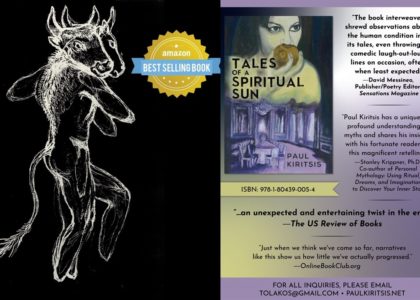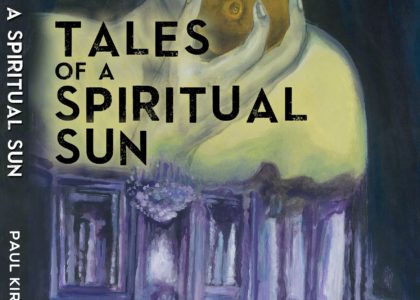
Choosing to contemporise, reconstruct, retell or interpret any ancient myth, particularly fragments of universally recognised mythological discourses such as Homer’s The Iliad and Odyssey or Hesiod’s Theogony, can be for the most part an incredibly daunting and hair-raising experience. Yet for any writer who intuitively penetrates the dark veil of entertainment or explanatory devices and sees myth as a primal mover in the narrative or story-telling process; for any writer who can acknowledge its intrinsic powers in reshaping and recasting the cosmic clay which forms the mould of knowledge, the cultural attitudes, behaviours, and values of any society, as well as any political ramifications that may ensue as a result, retelling these extraordinarily powerful and timeless stories somehow mimics a thermometer which measures and reflects the increment and nature of our collective consciousness, and acts as a necessary precursor to our evolutionary leap in critical thinking, inquiry and the way we process and evaluate information as a whole.
But before we go onto my preferred choice of subject, it is necessary to define the physiology, the internal components or “stuff” of what might be defined as “myth”. Strictly speaking, myths are sacred and timeless stories that attempt to make sense of an otherwise confusing and chaotic information universe. They also define and delineate the central Self from the unconsciousness matrix, illuminate the relationship between the microcosm of the Self and the macrocosm of the greater cosmos, recounting events pertaining to the origins and functions of the universe and all things, living or inanimate, contained within it. Most of the questions inexplicably linked with myth are abstract, philosophical in nature, and highly resistant to localisation in the three-dimensional, corporeal vacuum of time and space. You may think of myth consciousness as a baby struggling to make sense of its immediate environment despite its own helpless state of passivity in a world of meaningless associations. Information processing belonging to this level of evolving intelligence would inevitably come up with the following questions: Who am I? Who are we? How did I come to be? What is the world? How did it come to be? Who created it, and what are the moral, social codes of conduct that govern out behaviour and society as a whole? What are the consequences of law-making and law-breaking?
The word myth itself is derived from the Greek “mythos,” a term which denotes word or story. It appears that the pre-Socratic philosophers only referenced it in passing, and the concept didn’t really come to eminence in the intellectual world until the life and times of Plato who perceived it to be a literary vehicle encapsulating allegorical truth i.e. the mythos of Atlantis. The Platonic and Neoplatonic schools of thought were inextricably linked with the exploration of reality, dividing the cosmos into the eternal world of “being” which encompassed the intellect, divine forms and ideas, and the ever-fluctuating, temporal and chaotic world of “becoming”. It goes without saying that Platonic thought flirted openly with a psychological, ahistorical approach to mythography though little to no attention had been given to the hermeneutics of myth until well into the nineteenth century.
At about this time Sir James Frazer published The Golden Bough, a quasi-anthropological work defining mythological discourse as a preserved body of oral folklore which embodied the unconscious projections of pastoral dilemmas and traditions. Emerging in the twentieth century, Carl Gustov Jung and Sigmund Freud took a more holistic approach and saw myth as exploration of psychological terrain in which archetypal content of the human psyche emerged from the unconscious, subsequently forging dynamic relationships with one another and with the macrocosm at large. Joseph Campbell, the author of The Hero with a Thousand Faces, took the psychoanalytic point-of-view a step further and professed that the characters of myth and dream were urgent heroes who embarked on a long journey, underwent a struggle of some sort, and successfully emerged from it enlightened and anew, with a refined, resilient and an altogether more evolved identity. On the polar end of this hermeneutical scale sat French anthropologist Claude Levi-Streuss, who rejected the psychological internalisation of myth for a more impersonal model emphasising narrative strategy and plot device as the bone which formed the skeletal framework of all stories, be they compelling fiction or dramatic non-fiction.
My purpose here is not to analyse the scope of hermeneutical interpretation that has typified the study of mythography over the last few centuries but to give a millisecond flash, a fleeting glimpse, if you like, of the onion-skinned layers composing the mythological sphere. In this way, readers may garner a greater appreciation of its interdisciplinary, multifaceted nature. Thus, when entering the labyrinth of mythology, one must tread along the winding passages which harness a worm’s eye view of political, social, literary, performative, textual, psychological, astronomical, seasonal and structural aspects, but he or she must never lose sight of the birds-eye view, an impartial trajectory which succeeds in taking all into account without becoming localised.
Sadly, it appears that contemporary Western society is very eclectic in when it comes to choice of subject; most academics and students harbour an unconscious bias for Greek, Roman and Norse myths. If one elects to study mythology at tertiary level they’ll be surprised to find the subject reader askew with a profusion of classical texts. This lopsided representation of a universal phenomenon precludes mention of mythographical landscape from the “primitive” religions of Africa, South America and Australia, which are hardly, if ever, included in the syllabus plan. Even Egyptian and Gnostic mythologems have been largely ignored until now. The latter of these are especially significant, seeing that they’re the only surviving totems of heterogeneous religious communities that flourished between the second and the third centuries ce. These were peoples united by an ascetic way of life and a conviction that religious, spiritual insights pertaining to the nature of the cosmos, or Gnosis as it would have been called then, could only be arrived at through revelation. Only revelation could draw to oneself an experiential knowledge of reality that exceeded and was far superior to reason alone. Perhaps this distinct religious mentality is epitomised best by the second tractate of Codex IX of the Naq Hammidi Library, the Christian Gnostic Testimony of Truth, which asserts that: “When man comes to know himself and God who is over the truth, he will be saved, and he will crown himself with the crown unfading.”
Whilst being the only avenue to salvific knowledge, Gnosis was also of a highly esoteric in nature and therefore inaccessible to the unsophisticated majority. The Gnostics proceeded to estrange their contemporaries further by professing that all other avenues of knowledge available–rational, philosophical or otherwise–were no more than the well concealed and cleverly devised machinations of an evil Demiurge or creator demon named Yaldabaoth that was bent on destroying the soul-sparks of God’s favoured creatures. No doubt these sentiments would have done little to attract devotees to its divine mysteries. A systematic examination of the authentic Gnostic writings reveals to us that the Gnostic sects probably arrived at their morally righteous and inflexible convictions through a severe radicalisation of ideas that were themselves derived from Biblical wisdom literature, Greek philosophy and Christian theology. Ironically, an elitist mentality which included an outright rejection of all other forms of “knowing” on their part alienated contemporaneous religious currents (i.e. Hermeticism, Neoplatonism, Judaism) that were underpinned by the same fundamental belief in God’s absolute transcendence. Later still, when the patriarchal sects began to demarcate the variegated world of collective Christian beliefs and imbue it with their Iron Age attitudes, the Gnostic religion and its mythological variants was branded heretical and drastic measures were taken to ensure its suppression.
In order to garner an understanding of how the mythological Gnostic texts may have come about it is mandatory that we examine the cultural milieu of the period in which they were written. Most authentic Gnostic writings were penned between the first and fourth centuries ce, a time when the bustling, cosmopolitan city of Alexandria had evolved into a cosmic heart-centre of scholarship and research. Founded by Alexander the Great nearly four centuries beforehand, the city never quite enjoyed the status of world Capitol which its Greek cogitator had intended though it did, to some degree, become a sparkling diamond of the world’s collective intellectual inheritance before forfeiting its throne to Rome. Alexander never lived to see the ill-fated city built; that honour went to one of his Macedonian generals, Ptolemy Lagides (367-283bce), who seized Egypt as his personal fiefdom upon Alexander’s death in 323bce and founded the Ptolemaic kingdom. Despite the fact that they were somewhat dysfunctional, calamitous in disposition and all too often plagued by an unwavering absence of conscience, the Ptolemaic dynasty managed to rule Egypt from Alexandria for almost three centuries.
During that time, they partook in large-scale reconstructions of major Egyptian temples and facilitated the intellectual climate for which Alexandria would become famed by constructing the Great Library of Alexandria and proceeding to fill it with papyrological manuscripts seized from foreign vessels docking at its harbour. The endeavour attracted thinkers steeped in both Western and Eastern philosophical and religious lore, and by the first century ce they were pouring into the city’s five quarters from the four corners of the world to exchange ideas and rigorously acquaint themselves with foreign disciplines, however novel, ‘heretical’ or challenging they might have seemed. It was in such an intellectually rebellious and progressive climate that many disillusioned Jewish sects sought to fabricate an identity, given that back in Jerusalem the beliefs and practices of the mainstream religious movement had become dogmatic to the bone and saturated by Iron Age patriarchal sentiments.
For anyone with a healthy dose of common sense; for anyone able to think outside of the two-dimensional square imposed upon them by any religious dogma, it would make absolutely no sense at all that a masculine Godhead, or any Godhead in fact, would be capable of exhibiting tribal chauvinism, favouritism, hostility or any other less-than-desirable quality that could never be indigenous to the anatomy of enlightenment or divine benevolence. Further, why would a self-engendered creator depart from the law of eternal rumination in an ethereal realm for the trivial sake of involving himself in human affairs? Yahweh, the God of the Old Testament was prone to bouts of all these imperfections–and more! How could he be the One of the philosophers? The obvious answer was that he wasn’t. The biblical scriptures had it all wrong, as did the ancient Greeks who perceived their divinities to be little more than carbon copies of their flawed selves decked in the paraphysical attribute of life everlasting and imbued with magical powers.
Individuals belonging to the radical Jewish sects reasoned that Yahweh could never be the all-omniscient and transcendental being responsible for the majesty of the cosmos; on the contrary, his unruly, compromised, corrupt and conceited nature exposed him for the villain that he was–a malevolent demon called Yaldabaoth, the same being whom the Jews called Yahweh. While it was probably true that this demon had bought forth the material world from within himself, his malignant nature rendered him entirely ignorant of the powers-that-be that existed above him, and hence of the tiers of consciousness that served as stepping stones back to the realm of Absolute Spirit. The just mentioned was also called the Pleroma and was the ethereal light in which the true God ruminated and all human soul-sparks originated. Sadly their descent along the multidimensional rung which led to corporeal incarnation had the deplorable effect of erasing all trace of their divine source from memory, enabling Yaldabaoth, that master of material detritus and dross, to tyrannise over them by either destroying them completely or leading them ashtray.
The Jews were the first race to heed to the demon’s religiously-flavoured banter and to his meaningless laws. Before he could incite any further damage, the true God sent an extension of himself, an emissary in the form of Christ to pull aside humanity’s veil of forgetfulness and reveal the path of true salvation in all its splendour. But this gold-laden road wasn’t anything that could be arrived at through philosophical or experiential knowledge, love or ascetic morality even. Alas it could only be trampled through Gnosis or spiritual insight gained through revelation which, according to Christian Gnostic Theodotus (2nd century ce), imparted knowledge of “who we were and what we have become, where we were and into what we have been thrown, whither we hasten and from what we are redeemed, what is birth and what is rebirth.” Hence from the very beginning the esoterically revealed Gnosis of these heretical Jewish sects was something of an alloy spontaneously formed from the sacred marriage of Western and Eastern esoteric streams of spirituality with Christian dogma. Then it fused into a distinct religious mentality and found voice in third and fourth century Coptic texts, the most famous of which are the thirteen codices of the Nag Hammidi Library found on the mountain Jabal Al-Tarif in Upper Egypt.
The texts themselves are indispensable for they have served the historian as the trowel has abetted the archaeologist by unveiling the religious milieu of an era which was obviously quite variegated in character. In the process, many defining characteristics of the heterogeneous Gnostic movement of late antiquity have come to light, the most important of these being an almost numinous presence of the feminine archetype in mythological discourse and cultic practices that included women. Two in particular, the Coptic text Pistis Sophia and the Naq Hammidi tractate On the Origin of the World, disclose the androgynous state of the primordial power or the undifferentiated One in which the four pairs of transcendental beings inhabiting its ethereal fire are male-female consorts and counterparts. The name ascribed to the feminine entity responsible for the split in paradisal or uroboric perfection is Pistis Sophia, the embodiment of wisdom, a name which discloses her former identity as Pallas Athena, the virgin goddess of wisdom in the Greek pantheon. The fall of Pistis Sophia from the Pleroma is a fascinating story, for in it we see the fragmentation of the inflated ego from the collective unconscious and it’s subsequently reintegration with the archetypal self, the inexplicable link between the masculine and feminine archetypes, as well as a scrupulous regard for intuitive qualities and inward-looking tendencies that might be described as aesthetically feminine–unbounded wholeness, interconnectedness, love, reunion, and so forth. From this perspective, the Gnostic religion preserved the kernel of the feminine archetype as the cold preserves a corpse in a world that was gradually being scorched by the unfixed solar power of the divine masculine.









